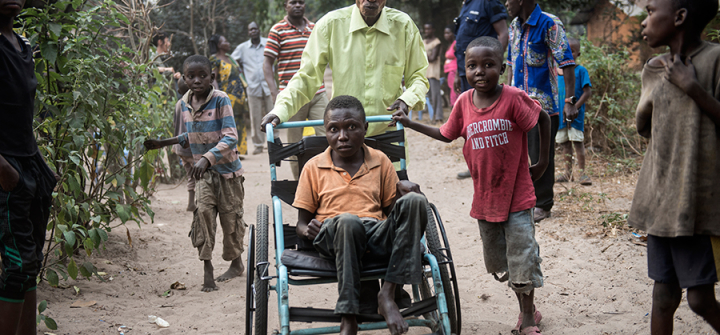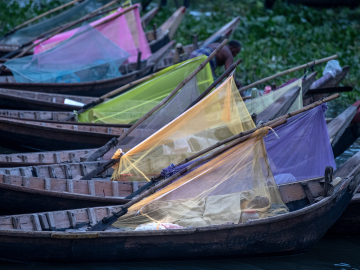Bitter Harvest: Cassava and Konzo, the Crippling Disease, Part III
Part III: The Warning Clock
DEMOCRATIC REPUBLIC OF CONGO — In a town known locally as “the place of suffering,” the eyes of a young man, Etienne Tshiluanji, beckon. They look defiant amid a sea of stares from a dozen people congregated outside of a community center, who wait to talk with me about their incurable, crippling condition called konzo. Tshiluanji sits in a wheelchair, if you can call it that. It’s a teal lawn-chair connected to bicycle wheels. His bones protrude to the surface of his flesh. His size suggests he’s around 15 years old. He tells me he’s 28.
I follow Tshiluanji home. His 2 young brothers hobble on twisted legs alongside his chair, which a bystander pushes through this remote town in western Congo, officially called Kahemba. Through the town’s sandy paths, some people stumble. Others crawl on their arms with their legs dangling like anchors behind them.
We arrive at a mudbrick house painted pale green. A woman sits out front. Her eyes are set back in deep sockets. She is Tshiluanji’s mother. She cannot stand because she too has been paralyzed by konzo—a neurotoxic disease that people succumb to when they have nothing to eat except for the white roots of cassava—a starchy, staple crop. The plant’s tissue can become rich in the poison cyanide when grown in soil as dry as sand; but people eat it when they have no alternative. So it is actually poverty that causes this condition—and it is konzo that makes an escape from poverty nearly impossible.
Like many men from this area, Tshiluanji’s father moved to Angola to mine diamonds 16 years ago. At first, he sent money home. But once his wife and his first son collapsed from konzo, the money stopped coming. He labelled them bewitched and never returned. Speaking the local language, Cokwe, Tshiluanji’s mother, Marie Kavumbu, tells me there is no hope for them. She cannot degrade cassava’s poison by soaking it in water for days because she physically cannot walk to the river. Neither can her three sons. She does not have the resources to irrigate the region’s parched soil so that less toxic crops grow. And the over-farmed land will only become drier as the climate warms.
Despite the post-apocalyptic scenes from this town, Tshiluanji looks as serene as a monk or a yogi. He tells me that in the biblical End of Times, unimaginable suffering foreshadows Jesus Christ’s return. He says, “This disease is a signal that we are nearing the end of the world.”

Etienne Tshiluanji (28, in wheelchair); Kudiva Mayele (9 yrs old) and Jonathan Mayele (7 years).
Konzo is not a new disease. In 1936, Belgium colonizers in the Congo described populations plagued by disability in both of their lower limbs. Their symptoms ranged from mild (a hobbled gait) to severe (complete paralysis). One tribe called the condition “konzo,” a name originally ascribed to antelopes that had been bound at their knees during religious ceremonies. Nor is the disease rare. In Kahemba alone, more than 3,500 people have been affected over the past two decades. Around Africa, numbers may be in the tens of thousands.
Konzo tends to occur in spurts, in drought years during which nothing else but bitter cassava will grow. And wherever it occurs—in remote regions of Congo, Mozambique, Tanzania, Cameroon, Angola and the Central African Republic—it exclusively afflicts the extremely poor (those living on less than $1.25 per day). They don’t have the fertile land, the savings or the market connections that would allow them to procure food beyond bitter cassava. If they had ample protein in their diet, their bodies could naturally detoxify the plant. That’s why I could eat cassava as I traveled around the Congo, whether it was prepared as a pasty lump called fufu, or fermented into a nougat-like snack.
The solution to konzo seems simple: Give people food, seeds and fertile land. However, there’s no sign that the Congolese government will be providing a safety net any time soon. On the contrary, people have been protesting in the streets of the capital Kinshasa this year, begging their current president, Joseph Kabila, to step down after nearly 30 years of corruption and conflict.
One NGO based in New York City, Action Against Hunger, did provide aid to address konzo in 2010 and 2011. In the Bandundu province, which includes Kahemba, the group gave away additional crops, such as cowpea and a variety of less dangerous, sweet cassava. They also educated the community about the cause of konzo, and how to prepare cassava in a way that lessens its toxicity. If you isolate the years surrounding the intervention, it seems like a success. In Kahemba, konzo dropped from 1,300 new cases in 2009 to 47 in 2011, according to the group’s 2014 report. But rainfall fluctuations likely account for much of the drop. Moreover, the people of Kahemba are now no more secure than they were before the transitory intervention. Donors had funded the NGO to carry out a well-defined, 3-year project (the first spent on assessment), and that’s it, explains Silke Pietzsche, technical director at Action Against Hunger. “We tried to get more funding after that so that we could try to make the project sustainable,” she says, “but it is very hard to find donors who want to support problems like konzo and other neglected diseases.”
The people of Kahemba felt abandoned. “When [Action Against Hunger] was here, you could see how people were stronger,” Cécil Mwandjombi tells me. At 63 years old, she’s the sole caretaker of three adult daughters who cannot walk due to konzo. “But the people came, gave a little help, and went,” she says. “They left some porridge in boxes, along with seeds, but now all of it is gone.”

Perhaps the crops from Action Against Hunger disappeared because they died during a harsh dry season. Bitter cassava is remarkable in its ability to withstand arid conditions. Desire Tshala-Katumbay, a Congolese neurologist and biochemist at Oregon Health & Science University in Portland who has long worked with konzo-affected people, wishes instead for solutions that are made sustainable through community leadership. This way, people would not need to rely on the whims of philanthropists. “International aid functions by providing seeds, or wheelchairs, or bags of food, and goes away,” he says. “The challenge now is for experts to come up with a form of aid that puts human lives at the center—that has the ultimate goal of reducing human suffering long term.”
Another explanation for why the safe cassava from Action Against Hunger no longer seems to be around is that it might have transformed over the years. Farmers in Kahemba say that plants grown from the same stock seem to become increasingly toxic over the generations. Their observation has been corroborated by evidence in the lab. Roslyn Gleadow, at Monash University in Australia, and her colleagues found that the roots of cassava plants grown in dry soil had 4 times more cyanide precursors (cyanogenic glucoside) than those from the same strain of plant, grown in the same type of soil, which was well-watered (Functional Plant Biology, 2013). “It is a plastic response,” Gleadow explains, “It’s not fixed like eye color, but more like having fair skin that turns red or tan in the sun.”
Gleadow pauses when it comes to another proposed solution to konzo: Cassava plants that are genetically modified to lack cyanide. As part of the Bill & Melinda Gates Foundation’s Bio Cassava Plus program, researchers have engineered cassava plants with inactivated cyanide genes. However, cyanide might provide some advantage to the plant that won’t be known until they’re tested for several years in konzo-affected places. Gleadow’s concern is that the modified crops may succumb to droughts, which would render them useless in the regions that need them.
And if the engineered plants do survive, Gleadow worries that the lack of cyanide will make them easy targets for insects that prey on drought-weakened plants. This could be why the plants make the toxin in the first place. “You don’t want to create a situation where suddenly people need to spray pesticides on their crops,” she says. Finally, if the modified crops require continuous replenishment of seeds, it could present the same problem as other forms of aid. Kahemba is so remote that getting products to the region is extraordinarily difficult. (Researchers listed on cassava modification projects did not reply to Global Health NOW’s requests for comment.)
Still, Gleadow thinks molecular biology has much to offer. In March, she and her colleagues published the cassava genome in Nature Biotechnology (2016). Now, researchers will be able to detect which genes control the toxicity of cassava, and which make them resilient to drought. This way, researchers could rapidly select varieties to breed, and then genetically test their offspring to ensure they have the right traits. Without genetic markers, traditional cassava breeding takes several years.
One benefit of natural breeding over engineering is that plants selected from the field might make just enough cyanide to ward off pests—but not harm people, says Gleadow. Also, naturally bred plants might harbor as-yet-unknown genetic traits that make them resilient. Finally, these crops would not foment public anxiety over GMOs.
In the meantime, konzo researchers recommend a simple solution that relies only on water. When cassava’s roots are soaked for several days, the toxic compounds break down. However, people who cannot make it to the river, or who have so little to eat that they cannot afford to let the roots sit, abbreviate this step to their own detriment.
In 2005, a retired chemist in Australia, Howard Bradbury, discovered a way to shorten the process from days to hours. He calls it “the wetting method.” People can pound the roots directly into flour, mix the flour with water, flatten the doughy mound, and dry it for 2 hours in the sun (Food Science & Nutrition, 2015). Bradbury has shown that his technique reduces cyanide in cassava flour by 3 to 6 fold. “When you mix the cassava flour with water an enzyme converts the cyanide compound into hydrogen cyanide gas, and the gas escapes from the flour into the air,” Bradbury explains.
In Mozambique, Tanzania, and Congo, researchers have taught women—the traditional cassava preparers—the wetting method. When they abide by the recipe, the number of konzo cases drop. This year, Tshala and his colleagues secured a grant to educate community leaders about the method, in hopes that they can continuously pass the knowledge on to their peers. Similarly, Bradbury collaborates with another Congolese researcher, Jean Pierre Banea, to teach communities the method. He funds this effort with small donations through the Australian National University.
Still, the wetting method will not change the fact that people are living on nothing except for a bitter root. Hans Rosling, a world-renowned Swedish epidemiologist, stresses how unstable and dangerous this state of extreme poverty is. “It’s where Ebola starts. It’s where Boko Haram hides girls. It’s where konzo is. It produces new diseases,” he says. “People in extreme poverty need economic development.” And that may call for a solution that’s not directly tied to konzo, such as a paved road to connect the region to markets where villagers can trade their goods, and become a part of the global economy.
Rosling calls konzo “a warning clock,” because it’s a manifestation of extreme poverty, which renders our world acutely vulnerable to violence and disease. Meanwhile, Tshiluanji, the young man in a wheelchair, sees it as a harbinger of the end of the world. As night falls in Kahemba, a neighbor brings by a basket of cassava roots. The family doesn’t know whether they’ve been soaked. They’ve heard their food may be poison. But they also haven’t eaten since the day before last. Because they cannot stand, the neighbor lights a fire below a pot of water to prepare the meal. Flames throw long shadows across the dirt yard.
Here is where we walk away.
Read the rest of the series: Intro to the Series; Part I: Desire's Antidote to Poison; and Part II: A Real Love Story
If you'd like to donate to an effort to protect people from konzo with "the wetting method," you can do so here, through Howard Bradbury at the Australian National University.
Special thanks to the Pulitzer Center on Crisis Reporting for supporting photography for this series.
Please join the thousands of subscribers who rely on Global Health NOW summaries and exclusive articles for the latest public health news. Sign up for our free weekday enewsletter, and please share the link with friends and colleagues: Subscribe to GHN
Etienne Tshiluanjim, 28, center in the wheelchair, leaving the Tomisa clinic in Kahemba with a group of children also suffering from konzo. Image by Neil Brandvold





